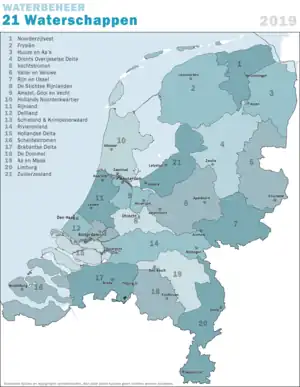The Netherlands has several levels of administrative subdivisions. The first level of subdivision consists of 12 provinces.[1] The second level of subdivision consists of 342 municipalities.
The country is also subdivided into 21 water districts, governed by a water board (waterschap or hoogheemraadschap), each having authority in matters concerning water management.[2][3] Direct elections of the water boards take place every four years.
Group of provinces

The Group of provinces (Dutch: landsdeel) is a European subdivision of the Netherlands. It meets the needs of Eurostat, the European statistical institute, which has defined a classification of territorial units for statistics. These groups correspond to the first European statistical level (NUTS 1).
There are four of them: Northern Netherlands, Eastern Netherlands, Western Netherlands and Southern Netherlands.[4]
Provinces
| Province | Coat of arms | ISO | Capital | Largest municipality | King's Commissioner | Number of municipalities (2023) |
Total area[5] | Land area[5] | Population[5] | Population density[5] | ||
|---|---|---|---|---|---|---|---|---|---|---|---|---|
| km2 | mi2 | km2 | mi2 | |||||||||
| NL-DR | Assen | Emmen | Jetta Klijnsma (PvdA) | 12 | 2,680 | 1,035 | 2,633 | 1,016 | 493,682 |
188/km2 (490/sq mi) | ||
| NL-FL | Lelystad | Almere | Leen Verbeek (PvdA) | 6 | 2,412 | 931 | 1,412 | 545 | 423,021 |
300/km2 (780/sq mi) | ||
| NL-FR | Leeuwarden | Arno Brok (VVD) | 18 | 5,749 | 2,220 | 3,336 | 1,288 | 649,957 |
195/km2 (510/sq mi) | |||
| NL-GE | Arnhem | Nijmegen | John Berends (CDA) | 51 | 5,136 | 1,983 | 4,964 | 1,916 | 2,085,952 |
420/km2 (1,100/sq mi) | ||
| NL-GR | Groningen | René Paas (CDA) | 10 | 2,960 | 1,143 | 2,324 | 897 | 585,866 |
252/km2 (650/sq mi) | |||
| NL-LI | Maastricht | Emile Roemer (SP) | 31 | 2,210 | 853 | 2,147 | 829 | 1,117,201 |
520/km2 (1,300/sq mi) | |||
| NL-NB | 's-Hertogenbosch | Eindhoven | Ina Adema (VVD) | 56 | 5,082 | 1,962 | 4,905 | 1,894 | 2,562,955 |
522/km2 (1,350/sq mi) | ||
| NL-NH | Haarlem | Amsterdam | Arthur van Dijk (VVD) | 44 | 4,092 | 1,580 | 2,665 | 1,029 | 2,879,527 |
1,081/km2 (2,800/sq mi) | ||
| NL-OV | Zwolle | Enschede | Andries Heidema (CU) | 25 | 3,421 | 1,321 | 3,319 | 1,281 | 1,162,406 |
350/km2 (910/sq mi) | ||
| NL-ZH | The Hague | Rotterdam | Jaap Smit (CDA) | 50 | 3,308 | 1,277 | 2,700 | 1,043 | 3,708,696 |
1,374/km2 (3,560/sq mi) | ||
| NL-UT | Utrecht | Hans Oosters (PvdA) | 26 | 1,560 | 602 | 1,485 | 574 | 1,354,834 |
912/km2 (2,360/sq mi) | |||
| NL-ZE | Middelburg | Terneuzen | Han Polman (D66) | 13 | 2,933 | 1,133 | 1,782 | 688 | 383,488 |
215/km2 (560/sq mi) | ||
COROP regions
A COROP region is a division of the Netherlands for statistical purposes, used by Statistics Netherlands, among others. The Dutch abbreviation stands for Coördinatiecommissie Regionaal Onderzoeksprogramma, literally the Coordination Commission Regional Research Programme. These divisions are also used in the EU designation as NUTS 3.
Water boards

Typically, a water board's territory is made up of one or more polders or watersheds. The territory of a water board generally covers several municipalities and may even include areas in two or more provinces. As of 2021, there are 21 water boards in The Netherlands. [6]
- Waterschap Noorderzijlvest (Groningen, Friesland and Drenthe)
- Wetterskip Fryslân (Friesland and Groningen)
- Waterschap Hunze en Aa's (Groningen and Drenthe)
- Waterschap Drents Overijsselse Delta (Drenthe and Overijssel)
- Waterschap Vechtstromen (Drenthe and Overijssel)
- Waterschap Vallei en Veluwe (Utrecht and Gelderland)
- Waterschap Rijn en IJssel (Gelderland)
- Hoogheemraadschap De Stichtse Rijnlanden (Utrecht and South Holland)
- Waterschap Amstel, Gooi en Vecht (North Holland, Utrecht and South Holland)
- Hoogheemraadschap Hollands Noorderkwartier (North Holland)
- Hoogheemraadschap van Rijnland (South Holland and North Holland)
- Hoogheemraadschap van Delfland (South Holland)
- Hoogheemraadschap van Schieland en de Krimpenerwaard (South Holland)
- Waterschap Rivierenland (South Holland, Gelderland, Utrecht and North Brabant)
- Waterschap Hollandse Delta (South Holland)
- Waterschap Scheldestromen (Zeeland)
- Waterschap Brabantse Delta (North Brabant)
- Waterschap De Dommel (North Brabant)
- Waterschap Aa en Maas (North Brabant)
- Waterschap Limburg (Limburg)
- Waterschap Zuiderzeeland (Flevoland)
Municipalities

As of 1 January 2023, there are 342 municipalities (Dutch: gemeenten). Municipalities are the second-level administrative division in the Netherlands and are subdivisions of their respective provinces. Their duties are delegated to them by the central government and they are ruled by a municipal council that is elected every four years. Municipal mergers have reduced the total number of municipalities by two-thirds since the first official boundaries were created in the mid 19th century. Municipalities themselves are informally subdivided into districts and neighbourhoods for administrative and statistical purposes.
These municipalities come in a wide range of sizes, Westervoort is the smallest with a land area of 7.03 km2 (2.71 sq mi) and Súdwest-Fryslân the largest with a land area of 523.01 km2 (201.94 sq mi). Schiermonnikoog is both the least populated and the least densely populated municipality at 23/km2 (60/sq mi). Amsterdam has the highest population with over 900,000 residents (31 March 2022), whereas The Hague is the most densely populated with a density of 6,620/km2 (17,100/sq mi).
References
- ↑ Provinces of Netherlands
- ↑ "De waterschappen" (in Dutch). Archived from the original on 3 November 2013. Retrieved 7 June 2013.
- ↑ "Mijn waterschap" (in Dutch). Retrieved 6 May 2021.
- ↑ NUTS 2021 classification
- 1 2 3 4 "Regionale kerncijfers Nederland" [Regional key figures Netherlands]. CBS Statline (in Dutch). CBS. 17 June 2020. Retrieved 20 June 2020.
- ↑ "Zoek Waterschap". waterschappen.nl. Retrieved 2 August 2021.